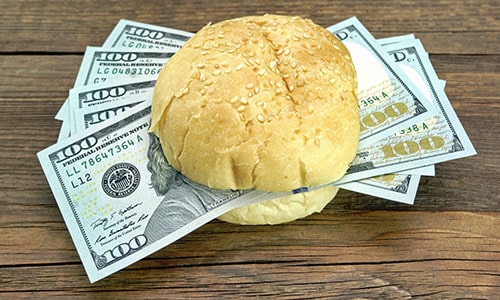702-660-7000
702-660-7000

According to a recent Bureau of Labor Statistics study, the average family spends 1 out of 3 dollars earned on housing. Intriguingly, this is more than a 100% increase over what Americans spent on housing in 1960.[i] Most of these costs are not negotiable and therefore can be difficult to adjust.
But another statistic is that 13.3% of earned income in America is spent on food (with more than 40% of that expenditure being on food away from home or take-out.)[ii] That is an interesting statistic, especially when, in 1901, nearly 50% of earned income was spent on food, but only 3% of that expenditure was on meals away from home and there was no take-out!
Granted, America is more mobile today than we were in 1901, but think about this for a moment. For Mother’s Day this year we ate out. The cost of that family meal was more than the cost of one weeks’ worth of groceries which would have fed our entire family and any drop-in guests abundantly. Or try to wrap your head around this fact: In 1982, my grocery bill was $75 a month while attending college. My brother-in-law suggested eating out for lunch instead of preparing my noon meal every day. But the cost was prohibitive. Eating out for lunch every day would have doubled my monthly food bill and that was only spending $2.50 for lunch every day!
Here is the #1 money problem in America today: Not saving enough money. Robert Shiller, the Nobel Laurate and Economics Professor at Yale confirms this blunt fact. And that is because saving money isn’t rewarded in our society like it used to be. In 1974, the savings rate was over 14% in the United States. Today, according to the St Louis Federal Reserve, we are saving less than 6%, and that savings rate is not enough to meet your future needs.
But savings doesn’t have to be difficult. All you have to do is have a good enough purpose.
When we were living in the lower 1/5th of income earners in America (i.e., poverty level) we made a decision that living that way wasn’t what we wanted to do the rest of our lives. So, we decided to save more. That choice is what changed our future. Not because we started making more money right away, but because we decided to save more of the money we were already making. Once we started saving more we were able to overcome our poverty and earn more money. But it took saving more before we began making more.
Obviously, how Americans spend money on food today has contributed to their savings deficit. In a recent Money article, Tim Gurner a multi-millionaire mentioned, that when he was saving to buy his first home, he “wasn’t buying smashed avocado for $19 and four coffees at $4 each every day.”[iii] The same goes for you and your building of wealth. Consider what you are spending on your food. Saving $10 a day and earning only 2% on that savings can put another $150,000 in your savings account 30 years from now. And based on the statistics listed above about food and groceries, most everybody in America could do that simply by rethinking your options for purchasing of food, groceries, take out, or dining out. Your choices can dramatically affect your savings and help you beat the #1 money problem in America today.
[i] https://www.forbes.com/2006/07/19/spending-income-level_cx_lh_de_0719spending.html
[ii] Ibid
[iii] ime.com/money/4778942/avocados-millennials-home-buying/